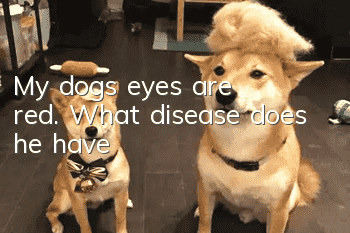My dog’s eyes are red. What disease does he have?

Dog's condition: Since a while ago, the whites of my dog's eyes have become very red, and sometimes there is some watery or mucus-like secretion. Some dogs have no discomfort in their eyes, but some dogs’ eyes become very uncomfortable and they cannot open their eyes very well. They want to scratch their eyes with their forelimbs or rub their heads against furniture or family members. I would like to ask them about their eyes. What problem occurred? How to deal with it?
Physician:
Red eyes are a common eye symptom in dogs, which often makes dog owners very worried. The causes and treatment considerations of red eyes are different in dogs. However, this problem is mostly caused by inflammation or abnormalities in specific parts of the eyes. If not Not only will the disease not be cured by treatment or self-medication, but some more serious cases will continue to worsen, causing serious consequences, such as vision loss or loss. Symptoms of unable to open the eyes are usually caused by blepharospasm due to pain or discomfort in the eyes. The behavior of scratching the eyes with the forelimbs or rubbing the furniture or family members with the head is a natural reaction caused by eye itching or discomfort. The following introduces the common causes and treatment principles of red eyes.
【Cause】
There are many causes of eye redness, which can generally be divided into two categories: "lesions on or near the surface of the eyeball" and "lesions within the eyeball." Of the latter, lesions within the eyeball must be diagnosed and treated as soon as possible. Avoid serious sequelae caused by late discovery. The following are two common causes of pink eye syndrome.
A. Lesions on or near the eyeball surface:
Common conditions include dry eye (dogs), conjunctivitis (a large proportion and a small proportion of dogs), conjunctival hemorrhage, corneal ulcers or trauma, third eyelid prolapse, etc.
1. Dry eye syndrome: The number one cause of red eye symptoms in dogs is also a reason that is often ignored. Dry eye syndrome may be due to a lack of tear film volume or a defect in the quality of the tear film, which prevents the tear film from adsorbing, protecting and nourishing normally. The surface of the eyeball (cornea and conjunctiva), causing symptoms of corneal lesions and conjunctival congestion and redness, must be treated according to the root cause to achieve effective and long-term improvement, rather than giving the patient a temporary treatment to make the eyes Red eye drops.
2. Conjunctivitis: It will cause extensive congestion and redness of the conjunctiva. In dogs, it is mostly non-infectious conjunctivitis, while in dogs, it is mostly infectious conjunctivitis. Canine conjunctivitis, except allergic conjunctivitis, is often accompanied by eye discharge.
3. Conjunctival hemorrhage: Often caused by trauma or impact to the head or eyes, the conjunctiva will appear bright red congestion or bleeding redness.
4. Corneal ulcers and trauma: The cornea is slowlyDuring sexual stimulation, ulcers, and trauma, blood vessels often proliferate on the surface of the cornea or near the wound, which can also cause extensive congestion and redness of the conjunctiva. Do not mistakenly think that the redness of the whites of the eyes is only a problem of the whites of the eyes, and ignore the cornea (black eyeballs). Some) lesions are often also responsible for the redness of the whites of the eyes. In addition, when ulcers or trauma occur on the cornea, it is much more painful than conjunctivitis and dry eye.
5. Prolapse of the third eyelid: There is a third eyelid in the inner corner of the dog's eye, which sometimes becomes red, swollen and congested due to prolapse.
B. Lesions within the eyeball:
Common intraocular lesions causing red eye symptoms include glaucoma and intraocular inflammation. These two conditions have more serious consequences and more complicated causes than lesions on or near the eyeball surface. If not treated early or effectively controlled, they will cause blindness or even stubborn pain in sick animals.
1. Glaucoma: Severe redness of the sclera in the white of the eye, edema of the cornea, increased intraocular pressure, and dilated pupils. Sometimes there is intraocular bleeding, eyeball pain and enlargement of sick animals, and the optic nerve and retina are rapidly and irreversibly damaged, which can easily lead to blindness and persistent pain.
2. Intraocular inflammation: The sclera in the white of the eye is severely red, with corneal edema, anterior chamber opacity, intraocular bleeding or suppuration. It can also easily lead to blindness, secondary glaucoma, and stubborn pain.
【Diagnosis and treatment principles】
For the above-mentioned causes of red eye, whether it is lesions on the surface of the eyeball, nearby lesions, or lesions within the eyeball, the sick dog must be sent to the hospital. Experienced ophthalmologists use several different ophthalmic instruments to treat the sick dog. Conduct detailed professional examinations on the surface of the eyeball and inside the eye to determine the degree, scope and cause of the disease, and then provide appropriate treatment based on the diagnosis of the eye examination.
There are many causes of red eye symptoms in dogs, and some lesions deteriorate rapidly. Only through a professional and detailed eye examination can we not ignore the eye lesions that deserve real attention and attention. It is most important to find the root cause of the red eye symptom. Only by treating the root cause can we achieve effective, long-term and real improvement. Rather than rashly giving the dog eye drops that temporarily make the eyes less red to suppress the symptoms, the temporary condition will suffer. If you cover it up and miss the best opportunity for correct and active treatment, the condition will only become more serious. Some commonly used eye drops can make the eyes less red temporarily, but some of the ingredients in them can cause the dog's lacrimal gland function to decrease or cause more serious corneal lesions after being used for a period of time. Therefore, dogs with red eyes should be cautiously treated by professional ophthalmologists. Only after examination and medication can the health of the dog be guaranteed.
- How to train Teddy puppy? How to train Teddy dog!
- Dog fracture symptoms
- How many puppies can a Shiba Inu have at one litter? Dog breeding!
- How does a novice train a dog to fetch a ball? What is the appropriate size of a dog training ball?
- How many shots do golden retriever dogs need to be vaccinated?
- Can dogs prevent pregnancy by taking birth control pills?
- Can dogs drink milk? Is it good for dogs to drink milk?
- Judging from the color of your dog’s urine, you can tell whether your dog drinks enough water!
- How to deal with ear mites in Maltese dogs
- How to remove excess eye mucus in dogs



